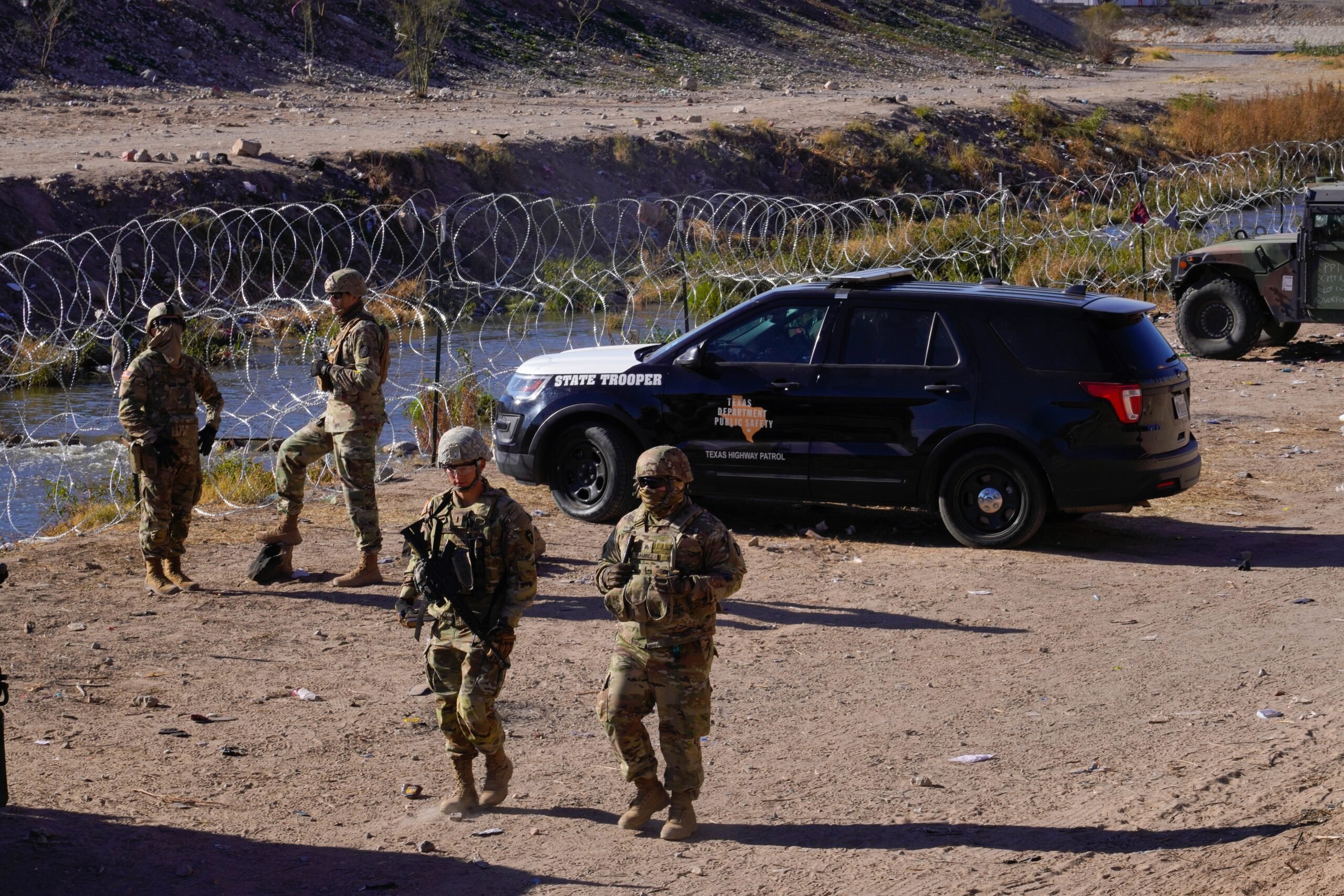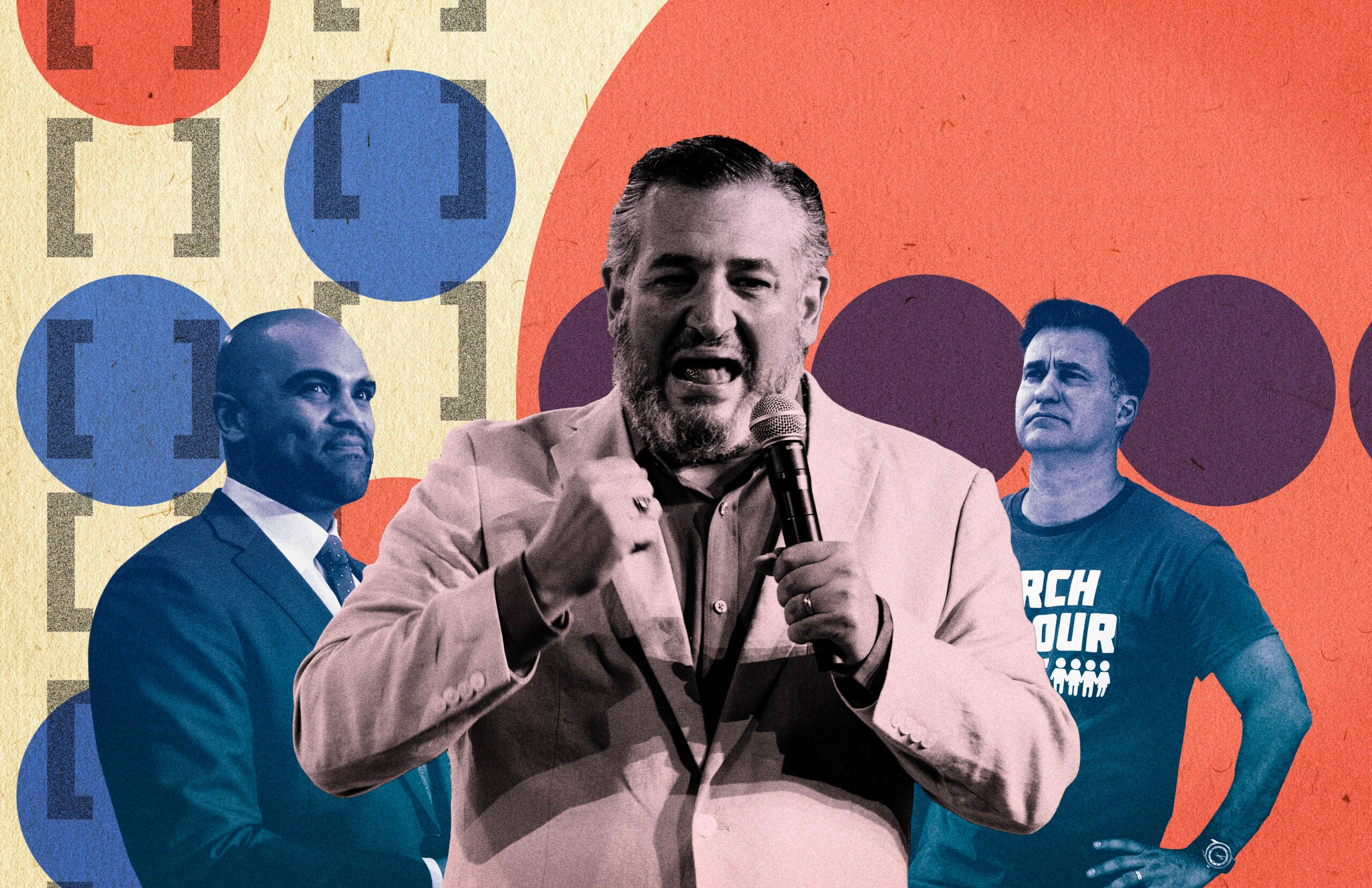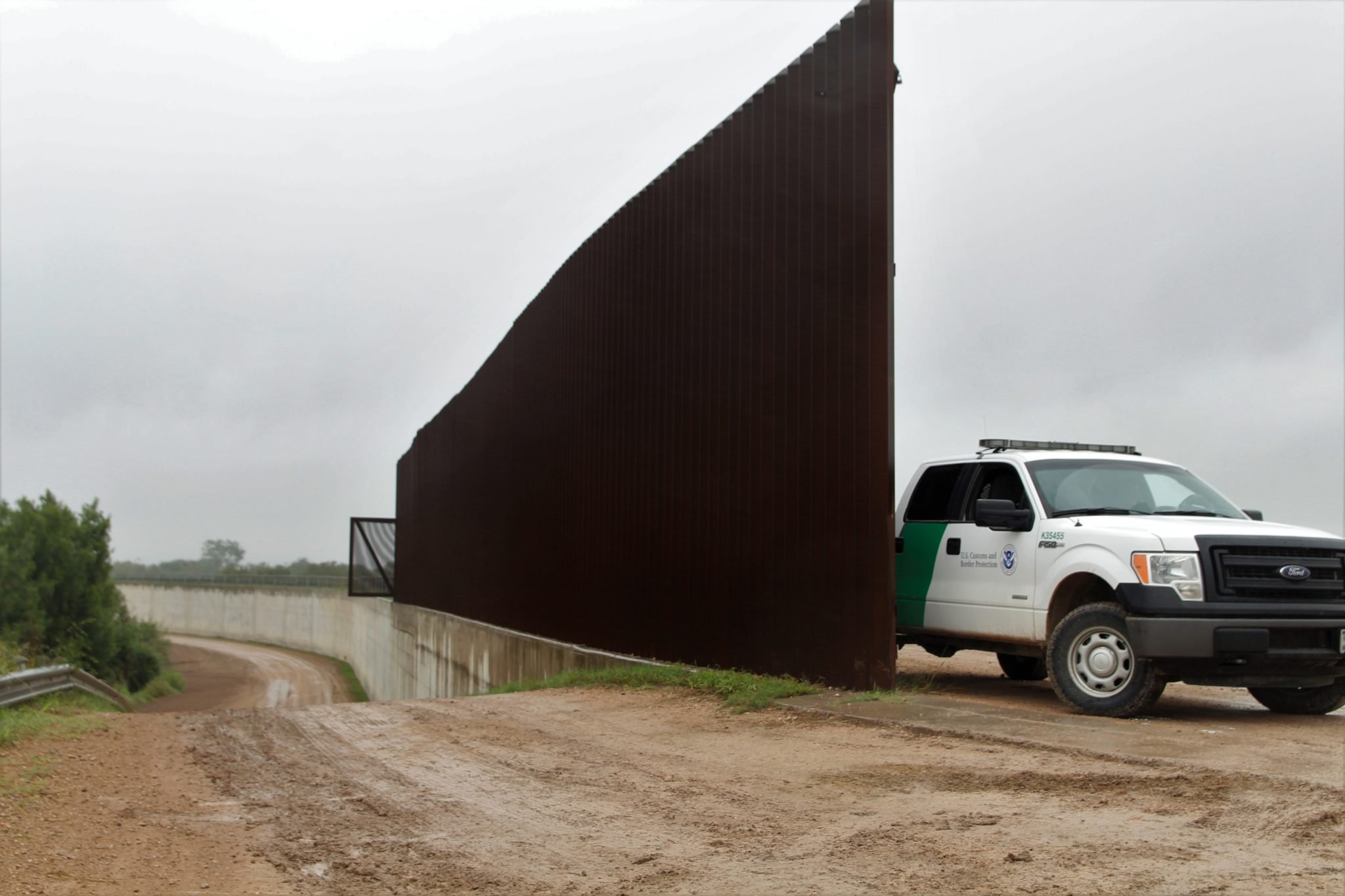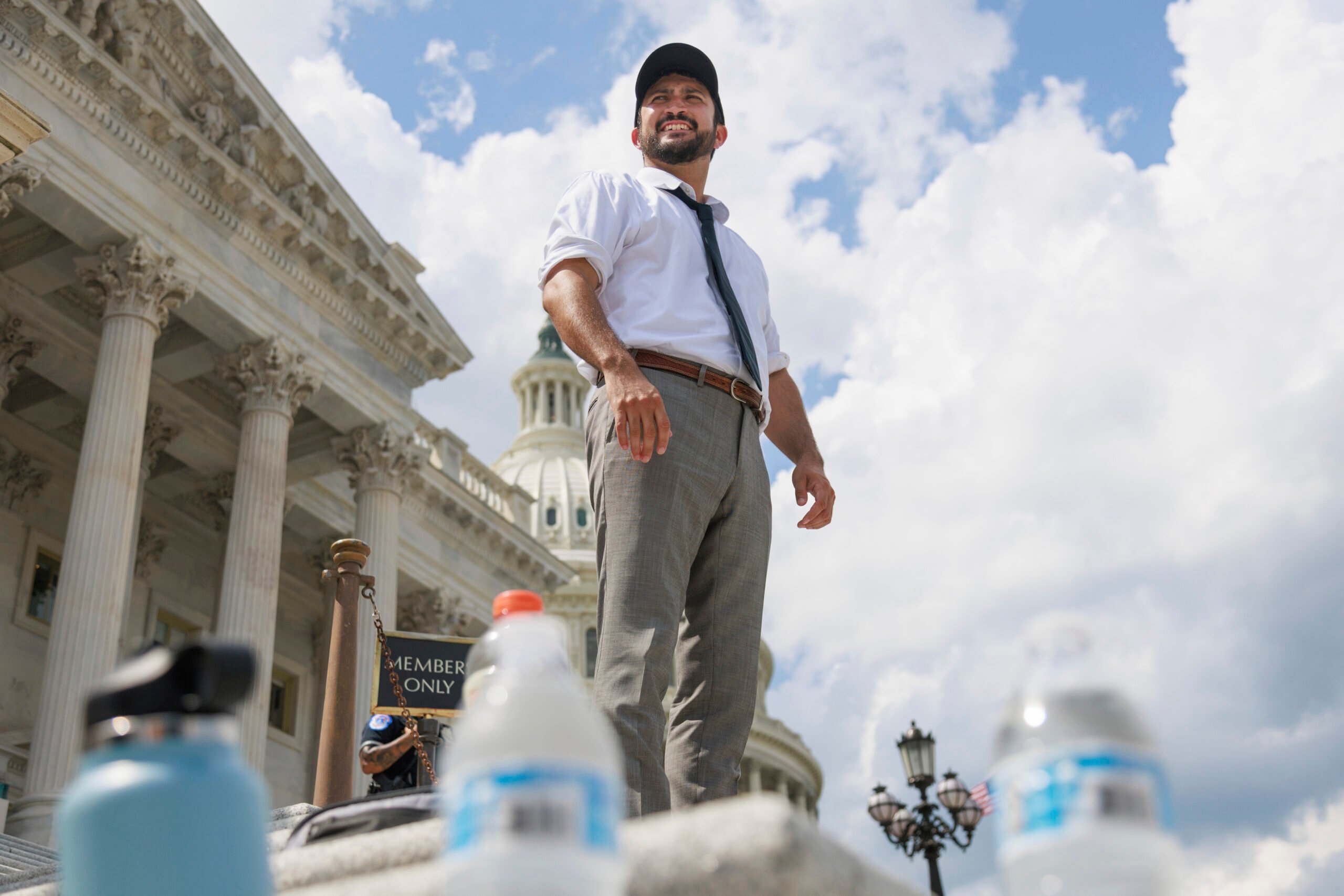
Fighting for Breaks on Multiple Fronts
Workers and activists implore Governor Greg Abbott to consider the dire need for protections in the record-breaking heat.

Less than an hour into the “thirst strike” held last week on the steps of the U.S. Capitol, one of the activists calling for enhanced protections for construction workers passed out. An ambulance came to treat her.
“A young, seemingly healthy woman fainted so soon, and yet construction workers, not just in Texas, but throughout the country, are expected to labor in this climate for eight, 12, or 16-hour days,” said Eva Marroquin, a 50-year old construction worker and business owner who participated in the strike. Her replies have been translated from Spanish. “It’s evident that extreme heat doesn’t just impact workers, but is damaging society as a whole.”
Marroquin and dozens of others—workers, activists, labor leaders, and politicians—were demanding protections for workers during what is expected to be one of the hottest summers on record in Texas. Headlined by Texas Congressman Greg Casar, the vigil and thirst strike aimed to put pressure on President Joe Biden to fast-track federal heat protection standards under the Occupational Safety and Health Administration (OSHA). The agency has been drafting heat safety standards since 2021, but the process is slow going. As of now, OSHA does not require water breaks for workers, nor does Texas state law. Since 2010 and 2015, respectively, Austin and Dallas have required 10-minute rest breaks for construction workers every four hours. But these local rules will soon be moot when House Bill 2127, which bans local ordinances mandating rest breaks as part of its larger aim to reduce local governmental power, goes into effect September 1.
“It’s evident that extreme heat doesn’t just impact workers, but is damaging society as a whole.”
After the display at the U.S. Capitol, the Biden Administration appeared to get the message. Days later, Biden announced that he had directed the U.S. Department of Labor to issue a “Hazard Alert” for heat, the first of its kind. This alert compels the department to provide information on how employers should protect workers from heat, make workers aware of their rights and protections, and explain the current status of OSHA rulemaking. In addition, Biden announced millions of dollars in investments toward mitigating climate change.
Just before the thirst strike, a group of lawmakers cosigned a letter to officials within the Department of Labor, asking for the “fastest possible implementation” of new OSHA heat standards, which, the letter said, should include rest breaks, workplace medical training for heat-related illness, and acclimatization plans, among other things. It doesn’t appear Biden’s announcement will hurry the OSHA rulemaking process along, but the efforts aim instead to provide resources in the meantime.
“The Biden Administration understands that families across Texas and America deserve dignity on the job and protection from extreme heat,” Casar said in a statement. “Together, we will finally win a federal heat standard and the right to water breaks and safety for every American worker.”
Speaking in Spanish via a translator, construction worker and thirst strike participant Nicolas Matom Marcos said he was “elated” by Biden’s announcement. “I feel motivated. It’s so fulfilling to know I’m part of a cause greater than myself and that it’s having an impact. I lost three days of work to be at the thirst strike but what came out of it was well worth the sacrifice.”
The president met with San Antonio Mayor Ron Nirenberg on the day of his announcement. San Antonio was considering passing its own local water break mandate when Governor Greg Abbott signed HB 2127 into law in June, quashing the city’s plans. Niremberg did not respond to requests for comment, but he criticized the bill during a televised appearance on Face the Nation after the announcement. “We’re trying to protect residents and workers, and they are doing everything they can to prevent that from happening,” Nirenberg said on air.
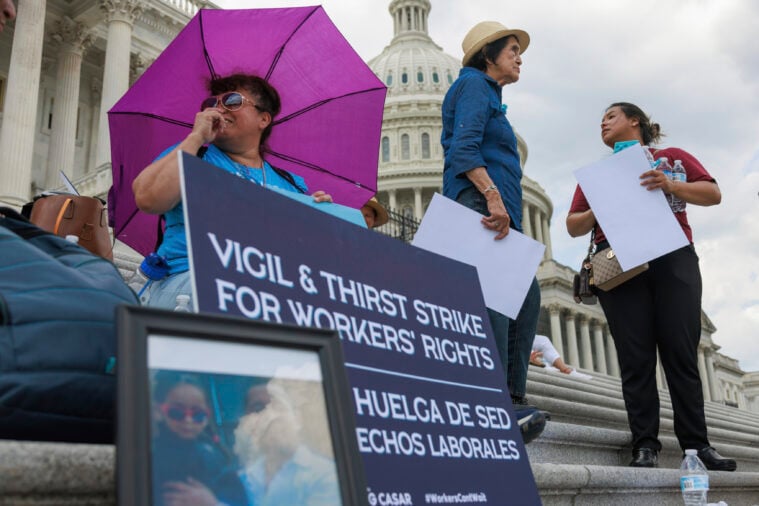
Now, workers and activists are calling for statewide protections as well. Daniela Hernandez, state legislative coordinator for the nonprofit Workers Defense Project (WDP), a community group advocating for Texas laborers, said she’s “excited about [federal’] initiatives” but that there’s “more work that needs to be done.” WDP, Texas AFL-CIO, and at least 180 other organizations are now asking Abbott to address heat safety in a special legislative session.
“[Texas lawmakers] are signing these bills in air-conditioned rooms,” Hernandez told the Texas Observer. “They have access to water, they can take breaks. We’re really just asking for workers to have equal protections. … I really hope Governor Abbott does end up addressing heat safety because these deaths, they’re preventable.”
Abbott’s move to subvert local requirements comes at a dangerous time for Texas workers, particularly those who work outside or in spaces without air-conditioning. July was the hottest on record in Austin and Houston, with the average heat index reaching 120 in Houston. Shortly after Abbott signed the bill, the League of United Latin American Citizens deemed it a “death sentence for Latino and Texas workers,” per the Houston Chronicle.
At least three Texans have died on the job due to the heat so far this year. Felipe Pascual, a 46-year-old construction worker, was pouring cement at a job site in the Houston area when he lost consciousness. He died at a Pearland hospital from hyperthermia, and the medical examiner confirmed he had no underlying medical issues. Justin Cory Foster, 35, had traveled from West Virginia to East Texas to help restore power in the area. He died in his sleep after a brutally hot shift as a lineman. Eugene Gates Jr., who had worked for the U.S. Postal Service for more than 30 years, died after collapsing during his mail route in Dallas.
As the death toll of the heat rises, countless more workers suffer injury or ailment.
Marisol Gayosso, a 46-year-old construction worker who attended the strike, said she’s experienced all the telltale signs of heat-related illness: dizziness, vomiting, bodily cramps. She spoke to the Observer through a translator. “Sometimes, I feel like I put my health at risk when I’m laboring out in the heat for an extended period of time.” Gayosso once witnessed a coworker pass out after struggling to paint a house in the heat. He ended up being taken to the hospital.
Marroquin—who’s also experienced vomiting, nausea, and excessive sweating—likens the feeling of working in the heat to the painful rush of sticking your face in a hot oven, opening a just-run dishwasher, or getting into a car that’s been sitting in the sun. “The difference is that the feeling is momentary in those instances,” she said. “When you’re laboring in this type of weather there is no escape from it.”
Kevin Lanza, an assistant professor at UTHealth Houston, said that combining heat and work “is a poor recipe, not only for one’s individual thermal comfort, but also for their health, their well-being, and their productivity.” Heat illnesses span a broad spectrum, culminating in heat stroke, which can lead to organ failure, loss of consciousness, and death. People performing physical labor outside are particularly vulnerable, Lanza said. “They’re doubly stressing their body.”
Outside of immediate physical threats, Lanza told the Observer that prolonged heat exposure on the job can have spillover effects. Physical strain can lead to a greater risk of accidents, which means lost income. Heat can also cause exhaustion and mental stresses that get carried home.
More than a decade ago, these same health concerns brought a group of demonstrators to the steps of Austin’s City Hall for a thirst strike to demand water break requirements. Casar, before his days as an Austin City Council member, was there. The Austin City Council took up the issue, much to the chagrin of local developers. (In a June 2010 Austin American Statesman article, the executive vice president of the Home Builders Association of Greater Austin is quoted accusing the city of “trying to usurp” the role of OSHA.) The city council ended up passing an ordinance requiring water breaks.
“When you’re laboring in this type of weather there is no escape from it.”
Five years later, about 40 protesters led by the Workers Defense Project showed up on Dallas’s doorstep with the same goal after Roendy Granillo, a local man, died on a residential construction site after reportedly being denied water breaks. The Dallas City Council soon passed its own ordinance.
But these ordinances will soon be sidelined and workers and advocates are imploring state and federal agencies to make a move.
These calls for action are brimming with urgency, but they’re certainly not new. The National Institute for Occupational Safety and Health made similar calls for protections from the heat more than 50 years ago—and the need has only become greater as climate change worsens extreme weather. A 2022 report from Public Citizen said a final OSHA rule could take from six to eight years to come to fruition.
In a letter published in the American Journal of Public Health in 2018, Texas State University lecturer Celeste Monforton said, “Experience tells us that workers cannot wait for OSHA. Every worker health and safety accomplishment came about by agitating and organizing.”
Some—but far from all—private companies have robust protections for their workers. Adrian Aguayo, a foreman with Local 49 Sheet Metal Workers in Amarillo, said that although he works outdoors and the indoor shop has no air-conditioning, his bosses are conscientious of heat safety. He is, too, especially with the younger workers. Aguayo said in his early years, the heat was much harder to bear, but his body has become more acclimated over time.
“I remember when I first got into this trade, I could feel my sweat running down my legs into my boots, thinking I’m not going to make it,” he said.
He said he recognizes not all workplaces are careful with worker safety in the heat—he’s worked for good companies and for bad companies.
“Water is essential for us. Without water, the work can’t be completed,” Aguayo said. “Whether union or not, every company should have [protections] on a union scale. It should be mandated and not taken from us.”
For proper enforcement, he said he thinks water breaks should be mandatory on a state level. Others, including Austin Mayor Kirk Watson, agree.
“Responsibility now falls entirely to the State of Texas to protect workers from this dangerous heat, and the best way to do so would be for the Legislature to pass statewide water break legislation,” Watson told the Observer. He pointed to the city’s 2010 ordinance as a model for potential statewide legislation.
It remains to be seen whether Abbott will respond to the uproar and take up the issue in a special session. Abbott’s office did not reply to a request for comment.

